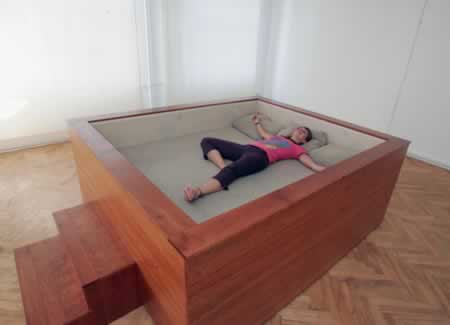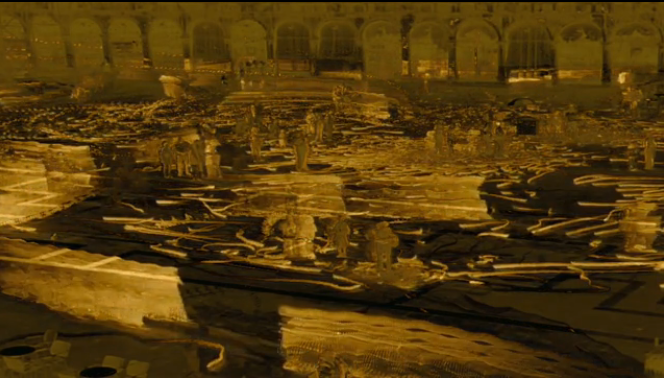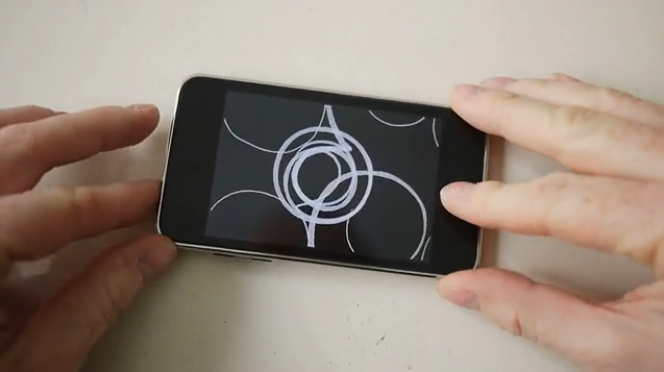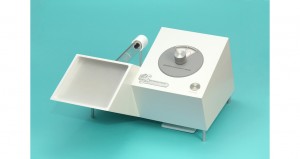Murmur Study – Christopher Baker

This installation explores the phenomenon of micro-blogging. The piece collects tweets and Facebook updates in real-time and continuously prints them out, creating an accumulated pile of the short messages people thought interesting enough to share on the internet. Using Processing and Arduino-controlled printers, Murmur Study is an elegant and physical reminder of the massive amount of information available on the web, while simultaneously exposing the narcissistic and social nature of humans. The piece is simple yet very effective. I think Baker could take if farther, for example by printing out every single Facebook status and tweets from all over the world, having printers on every wall of the room, and letting the paper flood the entire room.
Virtual Gravity – Silke Hilsing

In this interactive piece, Silke Hilsing tries to determine the physical weight of electronic data. This weight is not determined by the amount of data or literally what the actual data weighs, but is instead determined by its calculated importance. Weight is correlated to internet presence: how much the word is searched on search engines, etc… Hilsing created a sort of electronic balance, where participants can select different words and see which one is heavier (i.e. is more socially relevant). While the concept is really interesting, I feel like its execution is not quite up to par. I feel like the reaction it provides isn’t quite visceral enough, maybe because the medium itself still feels too electronic and Hilsing hasn’t quite fully translated the data into a more tangible, physical format.
Quintetto – Quiet Ensemble

A series of five tanks, each with a goldfish, emits sounds that are correlated to the position of the fish in the tank. This simple artwork is an engaging doorway into a different mode of perception. An interesting aspect of the piece is the mix of nature and technology, where organic bodies and electronic bodies collaborate unconciously. I like how the technology was used as a medium to further explore a relatively mundane, natural occurrence and elevates it to an artwork.
Comments Off on Looking Outwards 4

This is a group of new media artists who work in many different sorts of outputs. One sort that they do is building projections. Basically, projecting a show of sorts onto buildings, usually old castle-like ones. They also have this globe that tracks the videos being uploaded from locations all over the world constantly, and allows the user to pull up those videos onto the globe’s surface. They also recreated a working model of one of the cool interfaces from James Bond, and made some user-projection sorts of projects as well.
They have worked with sounds as well as images. They have a project that turns speech into visual output, along with movement tracking to create sound. They have a lot of other cool toys that should be checked out.
seeper — arts and technology collective.
Comments Off on seeper — arts and technology collective

This guy. Is AWESOME. Rafael Lozano-Hemmer is an Electronic Media artist who focuses on the “intersection of architecture and performance art.” He makes works that are reliant of interaction from an audience while using a variety of technological media like robotics and computerized surveillance.
Some examples are objects that react to pulse, groups of objects that react when people come close, projections that alter themselves as people interact with them, and using the projections that people create as canvases for his works. He has art all over the world and he has won a lot of awards for his stuff. His website has TONS of stuff on it, all AMAZINGLY cool.
Rafael Lozano-Hemmer.
Comments Off on Rafael Lozano-Hemmer

These beds react when a person lays down in it. Once someone enters the space of the bed and lays down in it, sound washes over them, giving them a musical experience that involves the entire body and not just the ears. It is an endless loop in order to last an entire night. It allows for people to experience sound in a new way, and many more are being made to be placed around the world. In the comments, it mentions that someone else made sound chairs that were similar conceptually. Still awesome.
Music for Bodies – Sonic Bed | Interactive Architecture dot Org.
Comments Off on Music for Bodies – Sonic Bed | Interactive Architecture dot Org

Untiled Faces
Untiled Faces by Nathan Selikoff is an interactive sculpture that displays chaotic systems, a complex mathematical model that can describe the evolution of a system in relation to time. Three levers, similar to those of a 70’s arcade game, allow viewers to move through a somewhat unpredictable four-dimensional parameter space. The rightmost and leftmost screens display the “strange attractors,” which are components of the chaotic system which is represented in the middle screen.

Simulen
Simulen by Jean Katambayi Mukendi is a prototype for the solution of the electricity distribution problems in the congo (as well as the rest of Africa). Because of the intermittent power, people manually tamper with the power lines to try and fix the brownouts that often occur, which cause overloads, tangles, and short circuits. In stark contrast, Simulen is made of paper and reassuring paperboard cubes, tinted with pastel colors which case the electronic wires, circuits and knobs. Also on Simulen are detailed drawings that illlustrate the inner workings in great detail. Mukendi’s work not only visualizes a problem that is central to Africa, but also teaches it’s people the phenomenon of electricity and what it does to help them.

Soplarte
Soplarte is a performance made by an orchestra of blown glass wind instruments. Each instrument has its own particular tone, although the sound variations offered by each model are quite limited. The rythmic variations of the musical performance also trigger movements in position from the performers on stage, making a harmony of bodies and sound. The translucence of the instruments also create a dazzling display of light.
Comments Off on
 Plot Against Time #1 (2007) (lower resolution excerpt) from David Rokeby on Vimeo.
Plot Against Time #1 (2007) (lower resolution excerpt) from David Rokeby on Vimeo.
David Rokeby’s “Plot Against Time #1” 2007
“Plot Against Time #1” captures the traces of pigeons and pedestrians on Venice’s Piazza San Marco. Each moving thing etches itself across the surface of the image in a golden hue which fades as time passes through a ruddy brown to pure black before dissolving into the background. Static objects in the scene are subtly present in a patinated green tone. The pedestrians leave slowly fading Futurist motion studies behind as they pass. The pigeons’ movements create a shifting map of trajectories articulating their interactions with each other and the tourists they seek food from, diagramming the peculiar ecology of the piazza.
Comments Off on Plot Against Time #1
 So.. I was at a party last night from Andrea Cuius on Vimeo.
So.. I was at a party last night from Andrea Cuius on Vimeo.
A collaboration between Creative Coder
Andrea Cuius and Designer Roland Ellis.
Conversations and interactions form the stimulus for this reactive light
installation. Each point of light has a character and together they form
a dynamic canopy complementing the frequencies and amplitudes of a performance.
30 tungsten lamps with intricate filaments are suspended above the performer.
The arrangement pitches toward the audience forming a luminous ceiling, such that
the stories might be told from beneath the sheets or within an alcove.
A microphone captures the audio, which is analysed real time producing the
canopy’s illuminating reactions. The analytical software is controlled live
to allow the poetry and the light to united in performance.
Comments Off on So.. I was at a party last night
 Multi-Touch Spin Art from Evan Roth on Vimeo.
Multi-Touch Spin Art from Evan Roth on Vimeo.
Compositions created with found software and a spinning multi-touch device.
Apps in order of appearance: Graffiti Anlaysis, Fat Tag, Yellowtail & Fat Tag Deluxe.
I find the documentation of the different applications fascinating. The fact that it displays 4 different versions of an almost identical program makes me wonder just where the space for individuality is left if so many things created are so similar.
Also, I don’t actively try to find posts with Golan in them, I’m just as surprised every time I do.
Comments Off on Multi-Touch Spin Art
The Quantum Parallelograph- by Patrick Stevenson-Keating

The Quantum Parallelograph gives viewers a glimpse into their hypothetical parallel lives. A viewer approaches the machine adjusts a dial and presses a button. A separate clear plastic tube attachment to the machine then lights up with the beam of a lazier. A small screen then lights up with a pattern that represents the splitting of that lazier into two different parallel universes. The machine then prints out a pink receipt that has a message from a parallel universe. The Quantum Parallelograph represents current theories about quantum theory in a playfully symbolic way. It ponders the consequences of parallel universes on the level of personal identity. It’s like a prop from science fiction popping into the real world just convincing enough to make you pretend.
A Tool to Deceive and Slaughter- by Caleb Larsen

The Tool to Deceive and Slaughter appears to be a medium sized black plastic box and it is. However, the Tool to Deceive and Slaughter is a medium sized black plastic box that has discovered the power of an ethernet cable and Ebay. One of the conditions of owning the Tool to Deceive and Slaughter is that you must provide it with an ethernet connection. As soon as this box makes that connection it will automatically put itself for sale on Ebay. Consequentially, this is a sculpture that eludes ownership by its very definition. Although, it is a physical object it behaves like a virtual one. I think this piece is a compelling blend of software and sculpture.
One Perfect Cube- by Florian Jenett

One Perfect Cube from Florian Jenett on Vimeo.
One Perfect Cube consists of three synchronized sets of clock hands sharing one large white surface as their backing. These clock hands are arranged so that every twelve hours these clock hands conjoin so they form the shape of a cube for exactly one second. The rest of the twenty four hours minus two seconds the clock almost approaches other distinct shapes, but never quite as clearly as the cubes. I really like how the artist used processing to serve a poetic ends that speaks to me about time, precision and anticipated action.
Comments Off on Looking Outwards 3 – Caroline Record
Hacked Knitting Machine
Andrew Salomone basically hacked a knitting machine from the 1980’s in order to control what the machine prints. He says in the video that he uses a couple different codes in python (another coding language) to convert photos into pixelated images that are then converted into the format of the machine. The machine controls two different colors of thread and by switching between the two threads can knit images into the fabric, which can then be taken off and sewn together to form sweaters or other knitted items. My personal favorite of his projects is the Cosby sweater project; I sincerely hope that Bill Cosby does agree to wear that sweater. View the video here.
Seating Habits

This informative and interesting infographic (alliteration!) maps out the various seating preferences of students in a particular MIT class for the summer semester. It shows each students seat in each class, and throughout the classes you can see bonds develop between students as they decide where to sit. Some students move around, from row to row, or from seat to seat, while others find a home and stay in it for the majority of the semester. You can also select certain students to see a smaller group of individuals and their seat choices. All that is said about who created this project is that it was designed and coded by skyrill.com.
Comments Off on Looking Outwards 2















